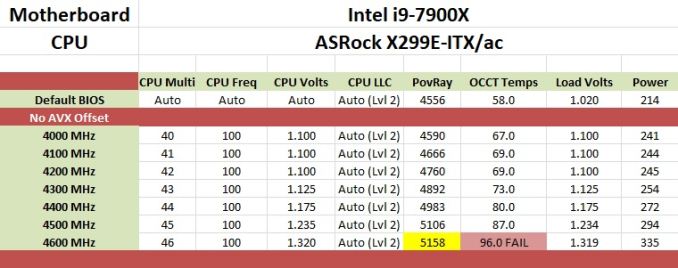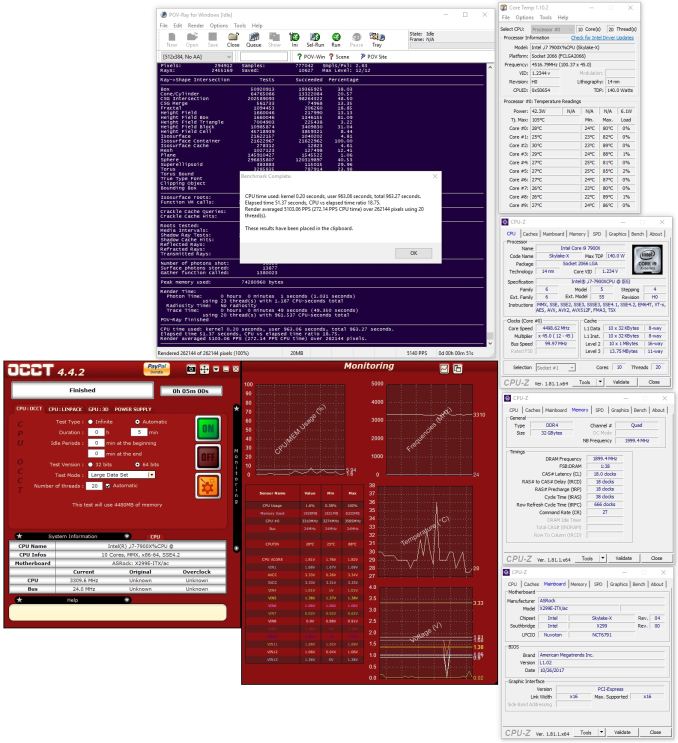The ASRock X299E-ITX/ac Motherboard Review: An 18-core No-Compromise Mini-ITX
by Joe Shields on December 4, 2017 8:00 AM ESTOverclocking
Overclocking Methodology
Our standard overclocking methodology is as follows. We select the automatic overclock options and test for stability with POV-Ray and OCCT to simulate high-end workloads. These stability tests aim to catch any immediate causes for memory or CPU errors.
For manual overclocks, based on the information gathered from previous testing, starts off at a nominal voltage and CPU multiplier, and the multiplier is increased until the stability tests are failed. The CPU voltage is increased gradually until the stability tests are passed, and the process repeated until the motherboard reduces the multiplier automatically (due to safety protocol) or the CPU temperature reaches a stupidly high level (90ºC+). Our test bed is not in a case, which should push overclocks higher with fresher (cooler) air. Room temperatures are normalized to 23C for all testing.
Experience with the ASRock X299E-ITX/ac
To start, the ASRock X299E-ITX/ac does not currently have automatic overclocking ability, outside of Multi-Core Enhancement. MCE brings all the cores to 4.5 GHz and uses more voltage than needed (1.29V compared with manual tweaking of 1.235V). The A-Tuning application does have an auto OC tune, however the option was not available with the latest release.
Manual overclocking was easy per usual, however with the ASRock BIOSes the most frequently used adjustments are in separate locations than with other BIOSes. There, most voltage options, multiplier, and BCLK were on the same page, while here there are in different sections. Not a big deal, however, it would be a bit more ergonmic if they were located on the same page. Users are able to achieve this through using the favorites page however.
The 7-phase VRM held up nicely through our testing. Though it did get hot to the touch, I did not notice throttling in our testing. The daughterboard for the SATA ports sits right over the VRM heatsink surely hindering airflow through the small heatsink. If heavy overclocking is a need on this board, I would suggest active cooling in a SFF case.
Overclocking Results
Using the X299E-ITX/ac we were able to achieve our typical limit of 4.5 GHz. This time at a slightly lesser voltage than most at 1.235V. Using the Auto function for LLC it defaults on Level 2 and yields pretty stable voltages. Voltage set at 1.235 V in the BIOS was measured as 1.234 V during load with Level 2 LLC. Power consumption of the system started off at 214W, and ended at 294W at 4.5 GHz.
The SO-DIMM DRAM used for the testing is specified at DDR4 3800 CL18-18-18-38 using the XMP profile. These are a bit different than the full-size DRAM sticks we normally use which are DDR4-2666 for one set and DDR4=3200 for the other. The OC testing was completed using these sticks set at the XMP profile. No other adjustments to the system were made.












24 Comments
View All Comments
CheapSushi - Monday, December 4, 2017 - link
If you're going to spend the money on this, why would you complain about not being able to use full DIMM just to save money? That's some odd penny pinching. And with your idea, you'd be compromising features just because of that, thus diluting the value of this. Are you planning to spend $$ ONLY to use it for less than a year or something? I don't see the issue. In fact more boards should embrace SODIMMs instead. Full DIMMs are a complete waste on consumer/gaming boards, especially mITX and mATX; much of the PCB is WASTED because of the lack of server features (ECC, buffering, extra voltage ICs, etc); this is often artificially segmented anyway.CheapSushi - Monday, December 4, 2017 - link
I really wish SODIMMs would become the norm on mITX mATX and even ATX for consumer/gamer boards. The DIMM PCB (thus size) is wasted when non-ECC/Buffered.CharonPDX - Tuesday, December 5, 2017 - link
Sheesh! I just want a Micro ATX Coffee Lake board with Thunderbolt 3 and WiFi built in for not a ridiculous amount of money.Rene23 - Saturday, December 9, 2017 - link
I need such a #mini-itx board for AM4 though, ... :-/